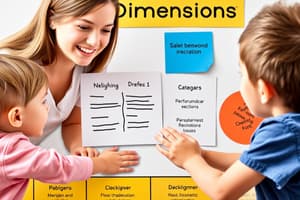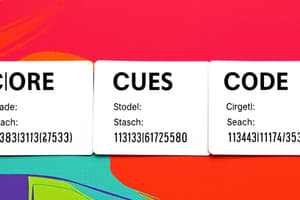Podcast
Questions and Answers
Which of the following best describes 'greenwashing'?
Which of the following best describes 'greenwashing'?
- A company misleading consumers about the environmental benefits of a product or service. (correct)
- A consumer's reluctance to purchase environmentally friendly products due to cost.
- A company genuinely investing in sustainable practices.
- A government initiative to promote eco-friendly products.
According to the '7 Sins of Greenwashing', the 'Sin of Fibbing' refers to promoting a product as environmentally friendly based on a single attribute while ignoring other negative environmental impacts.
According to the '7 Sins of Greenwashing', the 'Sin of Fibbing' refers to promoting a product as environmentally friendly based on a single attribute while ignoring other negative environmental impacts.
False (B)
Briefly explain the concept of 'Green-gap'.
Briefly explain the concept of 'Green-gap'.
It is the difference between a consumer's positive attitude toward sustainability and their actual purchasing behavior.
According to Cialdini's principles, the 'Principle of ______' suggests that people place a higher value on things that are scarce or limited in availability.
According to Cialdini's principles, the 'Principle of ______' suggests that people place a higher value on things that are scarce or limited in availability.
Match the following '7 Sins of Greenwashing' with their correct description:
Match the following '7 Sins of Greenwashing' with their correct description:
Which of the following reflects a company adopting a reactive approach to sustainability?
Which of the following reflects a company adopting a reactive approach to sustainability?
The SHIFT Method primarily aims to simplify complex behavioral changes individuals must make in order to be more sustainable.
The SHIFT Method primarily aims to simplify complex behavioral changes individuals must make in order to be more sustainable.
In the context of consumer behavior, briefly describe how 'Dual Cognition Systems' are utilized in marketing.
In the context of consumer behavior, briefly describe how 'Dual Cognition Systems' are utilized in marketing.
The 4 P's of the marketing mix are product, price, place, and ______.
The 4 P's of the marketing mix are product, price, place, and ______.
Within the Triple Bottom Line framework, which pillar focuses on ensuring fair labor practices and social justice for current and future generations?
Within the Triple Bottom Line framework, which pillar focuses on ensuring fair labor practices and social justice for current and future generations?
Flashcards
Definition Greenwashing
Definition Greenwashing
Företag vilseleder konsumenter genom att framställa sina produkter eller verksamhet som mer miljövänliga än de egentligen är.
Hidden trade-off
Hidden trade-off
Marknadsföra en viss del av produkten som hållbar utan att nämna andra delar av produkten som har negativ hållbarhetspåverkan.
No proof
No proof
Företaget marknadför att produkten eller en del av produkten är miljövänlig utan att ha konkreta bevis för detta.
Green-gap
Green-gap
Signup and view all the flashcards
Principle of Authority
Principle of Authority
Signup and view all the flashcards
Principle of Scarcity
Principle of Scarcity
Signup and view all the flashcards
System 1
System 1
Signup and view all the flashcards
System 2
System 2
Signup and view all the flashcards
Product (4 P)
Product (4 P)
Signup and view all the flashcards
Cultural Factors
Cultural Factors
Signup and view all the flashcards
Study Notes
Core Theories
- Greenwashing: Occurs when companies mislead consumers by portraying their products or operations as more environmentally friendly.
- This can involve misleading marketing, vague environmental claims, or focusing on minor sustainable initiatives to overshadow significant environmentally damaging activities.
- Consequences of greenwashing:
- Decreases consumer trust in sustainable products.
- Reduces consumer motivation to purchase sustainable products.
- Harms companies genuinely committed to sustainability and market transparency.
- Limits the potential for companies to transition to and focus on sustainable products.
- Slows down the transition needed to reduce the impact on the climate.
The 7 Sins of Greenwashing
- The 7 sins are misleading marketing tactics companies use to give the impression that their products or services are more environmentally friendly than they are.
- Hidden Trade-off: Highlighting a sustainable aspect of a product while ignoring other negative environmental impacts.
- No Proof: Claiming a product is environmentally friendly without providing concrete evidence.
- Irrelevance: Advertising an environmentally friendly aspect that is not relevant.
- Vagueness: Using vague and unclear terms like "green" or "environmentally friendly".
- Fibbing: Making outright false environmental claims.
- Lesser of Two Evils: Promoting a product as more sustainable compared to others in the industry, even if the entire industry is fundamentally unsustainable.
- Worshipping False Labels: Using self-made certifications that mimic official ecolabels to deceive consumers.
- Criticism of 7 Sins:
- Can lead to a "green hush," where companies avoid highlighting or doing sustainability efforts
- Can deflect attention from systematic changes.
Green-Gap
- Green gap is the gap between consumers expressing a positive attitude towards sustainability and their behavior.
- Reasons for Green Gap:
- Sustainable options can be more expensive.
- Consumers prioritize convenience.
- Distrust towards greenwashing.
- Difficulty in discerning truly sustainable choices due to lack of information.
- Impacts on consumer behavior:
- Internal conflicts between values and actions (cognitive dissonance).
- Choosing sustainable options in some areas but not others (selective consumption).
- High costs and inconvenience discourage sustainable choices.
- Mistrust of companies' sustainable claims.
- Social norms influencing consumption choices.
- Difficulty in changing established purchasing habits.
Reducing the Green Gap:
- Reducing price and increasing accessibility.
- Simplifying choices through clear labels and recycling systems.
- Building trust and transparency through reporting and certifications.
- Encouraging engagement through rewards and collaborations.
Cialdini’s 6 Principles (CARS SL)
- Principle of Consistency: People desire consistency with their previous actions.
- Principle of Authority: People listen to experts or authority figures.
- Principle of Reciprocity: People want to return favors.
- Principle of Scarcity: People value what is rare.
- Principle of Social Proof: People look to what others are doing to determine what is right.
- Principle of Likability: People say yes to those they like.
- Pros of Cialdini's Principles
- Effective influence tools
- Applicable accross contexts
- Focus on psychology
- Science based
- Cons of Cialdini's Principles
- Human behavior isnt always logical or predictable
- Focus on short term behavior change, not long term habits
- Context dependent, so not always effective
- Criticism of Cialdini:
- Lacks a long-term sustainability perspective
- Is more focused on influence than collaboration
- The risk of overuse, undermining effectiveness
SHIFT Method
- Framework to shift consumers to sustainable consumer behavior with psychological factors.
- Social Influence: People are influenced by the decisions and behaviors of others.
- Habit Formation: Behaviors become automatic through repetition.
- Individual Self: Personal identity and values influence choices.
- Feelings and Cognition: Emotions and thinking affects decisions.
- Tangibility: Abstract results of sustainable behavior can create distance.
- Pros of SHIFT:
- Designed for influencing sustainable consumer behavior.
- Increased awareness of sustainable alternatives.
- Cons of SHIFT:
- Oversimplification of behavior change.
- Focuses on individuals rather than systems and regulations.
- Time-consuming to change consumer behavior.
Dual Cognition Systems
- Used in marketing to understand and influence consumer behavior.
- By understanding how people make decisions with System 1 or System 2, marketers can make campaigns more effective.
- System 1 (feelings based):
- Automatic & fast
- Intuitive
- Experimental
- Unconscious
- Implicit
- System 2 (cognition based):
- Controlled & slow
- Analytical
- Rational
- Conscious
- Explicit
- System 1: Fast, automatic, and emotional.
- System 2: Slow, controlled, and analytical.
The Buying Process
- Model that describes the steps a consumer goes through to make a purchase.
- Need Recognition: The consumer identifies a need and seeks a solution.
- Information Search: The consumer searches for information through friends, the internet, or in stores.
- Evaluation of Alternatives: The consumer compares options based on price, quality, etc.
- Purchase Decision: The consumer makes a purchase.
- Post-Purchase Behavior: The consumer evaluates the purchase.
- Model Advantages:
- Structured and easy to understand.
- Helps companies understand consumer behavior.
- Helps inform marketing strategies.
- Especially applicable to complex purchases.
- Model Disadvantages:
- Too linear and rational.
- Simplifies the information search process.
- Primarily applicable to high-involvement purchases.
- The impact of habits and previous experiences are not properly accounted for.
4 P: The Marketing Mix
- Classical model in marketing that helps companies build strong strategies.
- Product: Features companies offer.
- Price: Pricing strategies.
- Place: Sale and product distribution location.
- Promotion: Adverts, PR, promotional campaigns, strategies.
- Advantages
- Provides structure for company to plan marketing effectively.
- Can be applied to industries and markets effectively.
- Can ensure the correct offer is available for purchase and at the correct cost.
- Gives edge over competitors.
- Gives clear communication.
- Disadvantages
- Model focuses on company needs, rather than the customer experience.
- Is intended for products and not for service driven companies.
- Focuses on mass marketing rather than focused marketing.
- In a modern world, it does not take into account social media or e-commerce.
- Is tactical rather than strategic.
Key Factors Influencing Consumption
- Cultural:
- Culture, subculture affects norms and purchasing habits.
- Social:
- Reference group, family influence consumer choices through trends.
- Personal:
- Age, lifestyle, personality affect consumer choices.
- Psychological:
- Motivation, attitudes (sustainability)
- Contextual:
- Macro context guide decision, and purchasing.
Triple Bottom Line
- Sustainable design includes planet, people and economy.
- Social sustainability ensures fair living conditions and social justice, rights, equality.
- Economic sustainability builds stable economics and effective resource use.
Ecological Sustainability:
- Focuses on minimizing negative environmental impacts.
Nudge
- Nudge is a concept in behavioral economics that involves subtly influencing people's behavior.
- The goal is to get people to make decisions without limiting their freedom of choice.
Defensive, Reactive, and Proactive Approaches to Sustainability
- Companies react differently to sustainability requirements according to their goal.
- Defensive:
- Considers increased sustainability requirements hurts the company.
- Reactive:.
- Ignore regulations as much as possible.
- Proactive:
- Wants sustainability, now, makes it core part of operation.
- Defensive:
Studying That Suits You
Use AI to generate personalized quizzes and flashcards to suit your learning preferences.




